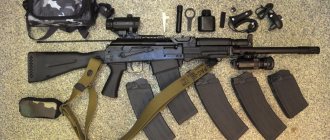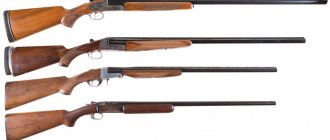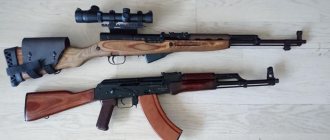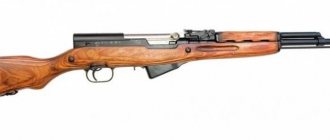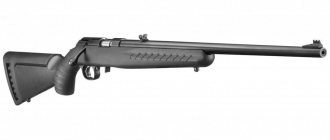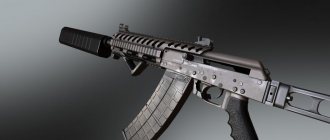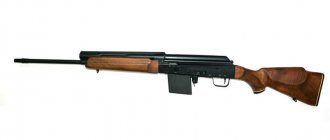- November 18, 2018
- Weapons and ammunition
- Natali Michaelis
Modern models of hunting weapons meet most of the requirements of Russian hunters. The best example is the Saiga 12K carbine, which was created on the basis of the reliable Kalashnikov assault rifle. Today, there are many modifications of this smooth-bore weapon, which are produced in various designs and for various purposes. The arsenal of the Izhevsk Machine-Building Plant is famous for its reliability and ease of operation. We'll talk about this in more detail in our article.
Brief history and description
The Saiga smoothbore carbine was first released in 1990. Its development was carried out by the IZHMASH plant, which by that time had already become famous for the large number of machine guns, rifles and carbines produced. Despite the fact that quite a lot of time has passed since the release of Saiga, the 12K sample does not lose its popularity. Moreover, the plant annually replenishes its model range, producing more and more new models of this hunting rifle. In addition to the model described, it is worth paying attention to such carbines as Saiga 20 and Saiga 20c, produced in 20 gauge.
Visually, the Saiga 12K is very similar to the Kalashnikov assault rifle, however, this smoothbore carbine is designed to fire 12-gauge cartridges. The peculiarity of this type of weapon is that, despite the years of development of the weapons industry, no one has yet managed to surpass a semi-automatic carbine in terms of technical characteristics (thanks to AK). The weapon is highly reliable, unpretentious to operating conditions, has a fairly simple design and does not require frequent lubrication, which is quite nice.
Operating principle
The automation system of the Saiga-12 carbine is inherited from the Kalashnikov assault rifle, is distinguished by a high degree of reliability and is capable of functioning normally even in severe pollution.
The Saiga-12 carbine is reloaded using the energy of powder gases removed from the barrel.
- When the trigger is pressed, the hammer is released, the striker strikes the cartridge primer, the primer ignites and ignites the powder charge, and a shot occurs
- During a shot, part of the powder gases from the barrel bore, through a hole in the upper wall, enters the gas chamber
- In the gas chamber, powder gases act on the gas piston, which, moving inside the gas chamber, pushes the bolt frame rod and thereby forces the bolt frame to move back
- The bolt is unlocked, the cartridge case is preliminary released from the chamber, then the spent cartridge case is ejected to the right through the window in the receiver by a spring-loaded ejector and receiver reflector
- The bolt carrier compresses the return spring and cocks the hammer into the firing position
- Powder gases are removed from the gas chamber into the atmosphere
- Under the action of the return spring, the bolt moves forward, sends a new cartridge from the magazine into the chamber, and turning around its axis, locks the barrel bore. The carbine is ready for the next shot.
12K and 12C - what is the difference
The Saiga 12K shotgun has fundamental differences from the no less popular Saiga 12C smoothbore carbine. The main one is the length of the barrel, since the 12K model had a specially shortened barrel in order to increase the technical characteristics of the weapon.
Also, another distinctive feature is the presence of a locking mechanism (Saiga 12C does not have one). Saiga 12K has a very short barrel, so the length of the weapon with the butt folded is less than 800 millimeters. According to federal law, such parameters are unacceptable, therefore, before firing a shot, it is necessary to unfold the butt and then remove the weapon from the safety catch.
In all other respects the models are similar. Both weapons are designed for hunting fur and feathered game and both can be upgraded with a variety of accessories and attachments.
TTX "Saiga" in 12 gauge version
The automatics of a smoothbore gun work similarly to the automatics of an AK, which formed the basis of the Saiga series hunting weapon. The entire layout and design of the gun is practically no different from the Kalashnikov assault rifle, except for two significant differences:
- The ability to fire automatically has been removed—to fire the next shot, you must release and press the trigger again;
- Saiga-12 has a special gas regulator, since this weapon requires the use of powerful 12/76 mm cartridges for hunting.
The general characteristics of Saiga smoothbore shotguns differ only due to the length of the barrel (and the Saiga-12 barrel has several length options) and the caliber of ammunition that is used when shooting.
Specifications
The 12 gauge Saiga smoothbore carbine has a number of positive features. He absorbed most of them from his prototype, the Kalashnikov assault rifle, but one should not think that the weapon does not have unique features. In order to verify this, it will be enough to look at the weapons passport, which is mandatory with the weapon set, and look at its technical characteristics. They will look something like this:
- type – self-loading smoothbore carbine;
- caliber - 12 millimeters;
- weapon height - 190 millimeters;
- barrel length - 430 millimeters;
- unloaded weight – 3.5 kilograms;
- operating principle – gas engine;
- number of cartridges in the clip – 10+1;
- sighting devices - rear sight and front sight;
- possibility of installing additional sights – available;
- butt is folding.
Based on these technical characteristics, we can say that the weapon is ideal for hunting medium and large animals. The sighting range of a smoothbore carbine loaded with a 12-gauge cartridge is about 50 meters. The accuracy of the shot remains within 50% up to a distance of 65 meters. At longer distances, the weapon is considered practically useless.
Disassembly, assembly and maintenance
Disassembling the Saiga-12 carbine is necessary for its cleaning, maintenance or repair. To disassemble the carabiner, follow these steps:
- By pressing the magazine locking latch and pushing the bottom of the magazine forward slightly, disconnect the magazine
- By lowering the safety catch down and moving the bolt to the rearmost position, check that there is no cartridge in the chamber
- Remove the receiver cover together with the return mechanism; to do this, press down the protrusion of the return mechanism, pull the receiver cover up and separate it from the carbine by moving it backwards
- Separate the return mechanism
- Move the bolt carrier to its rearmost position, remove it upwards from the receiver guides along with the bolt, separate the bolt frame from the carbine
- Separate the bolt from the bolt frame, to do this, move the bolt to the rearmost position and turn the bolt by the head counterclockwise so that it disengages from the groove of the bolt frame, remove the bolt from the frame channel
- If necessary, disassemble the shutter by knocking out the fixing pin
- Unscrew the gas regulator, pressing its stop with the tip of the screwdriver from the accessory kit, remove the gas regulator
- Remove the gas piston
- If necessary, separate the forend by unscrewing the screw of the front swivel and removing it, then remove the forend moving forward and downward.
The carbine is assembled in the reverse order.
Advantages
The 12-gauge smoothbore Saiga has a number of advantages over other carbines, thanks to which it is so loved not only by Russian hunters, but also abroad.
- The ability to install additional sighting devices of almost any type: from a collimator and diopter to an optical sight with a thermal imager or night vision device.
- Quite a convenient design of the gun with a relatively light weight. This feature allows the Saiga to be used by almost any hunter of any size.
- Possibility of purchasing a magazine for 4, 8 and 10 rounds. You can also load one round into the receiver, so the maximum amount of loaded ammunition is 11 rounds. Convenient for hunting game birds, where reload speed is important.
- Resistance to various adverse external factors. Like the Kalashnikov assault rifle, the Saiga is quite unpretentious. It will continue to shoot in the cold, in the rain, and even in the mud.
- A simple design, similar to a Kalashnikov assault rifle. Due to this feature, assembling and disassembling the saiga will not be difficult for anyone who listened carefully to the teacher during life safety lessons.
These are not all the advantages of a hunting rifle. The 12-gauge Saiga has excellent technical characteristics and fighting qualities, so you don’t have to worry that the lethal force of the weapon is not enough to kill an elk or a wild boar. The most important thing is to make a well-aimed shot.
Design of the Saiga-12 carbine
Trunk
The barrel of the Saiga-12 carbine can be from 330 to 680 mm long, depending on the modification and design of the carbine. Saiga-12 carbines have a barrel caliber of 12/70 or 12/76.
All modifications and versions of the Saiga-12 carbine have chrome-plated bores and chrome-plated chambers. Chrome plating provides a long barrel life and simplifies weapon maintenance.
The Saiga-12 carbine can have permanent or replaceable choke constrictions. Replaceable choke constrictions increase the efficiency of use and expand the possibilities of using the carbine.
The accuracy of the carbine on a target with a diameter of 750 mm at a distance of 35 meters with a muzzle narrowing of 1.0 mm is 60% for Saiga-12 and Saiga-12S and 40% for Saiga-12K and Saiga-12S EXP-01.
The barrels of some modifications of the Saiga-12 carbine are equipped with a muzzle compensator.
Sights
Most modifications of the Saiga-12 carbine are equipped with open sights, which for hunting versions can be in the form of a front sight and rear sight or an aiming bar, and for tactical versions in the form of a standard front sight and rear sight for a Kalashnikov assault rifle. Sports versions of Saiga-12 do not have standard sights. Most modern modifications of the Saiga-12 carbine are equipped with a rail for installing an optical or collimator sight.
Automatic and shutter
Reloading of the Saiga-12 carbine is carried out by removing powder gases through the upper hole in the barrel wall. The gas vent mechanism of the Saiga-12 carbine differs from the gas vent mechanism of the Kalashnikov assault rifle and the rifled versions of the Saiga family carbines. The gas piston of the Saiga-12 carbine is a separate part from the bolt frame. The gas piston moves inside the gas chamber, pushing the bolt frame rod. Mechanical decoupling of the gas piston and bolt frame allows the shooter to be protected in the event of excessive gas pressure in the gas chamber.
The gas chamber is closed with a screw plug, which is also a gas regulator that regulates the volume of powder gases entering the gas chamber. The gas regulator has two fixed positions: one position for magnum cartridges, the second position for conventional cartridges. Thanks to the gas regulator, Saiga carbines began to work normally with both cartridges with a case length of 70 mm, and with semi-magnum cartridges with a case length of 73 mm and magnum cartridges with a case length of 76 mm.
The most modern modifications of the Saiga carbine (Special 030, etc.) are produced without a gas regulator, but can work with any type of cartridge.
The barrel of the Saiga carbine is locked by turning the bolt, while the two lugs of the bolt fit into the grooves of the receiver. The shutter is rotated by bevelling the bolt frame. The return spring is located in the longitudinal channel of the bolt frame. The bolt handle is part of the bolt frame and is located on the right.
Trigger mechanism
The trigger mechanism of the Saiga-12 carbine is intended only for firing single shots, therefore it does not have the self-timer mechanism found in the Kalashnikov assault rifle: there is no self-timer tide on the bolt frame, there is no retarder in the trigger mechanism, the trigger, sear and safety switch have been changed .
Modifications of the Saiga-12 carbine with folding butts are equipped with a mechanism for blocking the possibility of firing a shot with the butt folded.
Modern modifications of the carbine: “Saiga-12K Tactics” and “Saiga-12S-EXP-01” are equipped with a forced slide stop, which greatly simplifies reloading the carbine. Some modern modifications of the carbine, for example "Saiga-12S-EXP-01", instead of the traditional safety lever, are equipped with a push-button safety, which is more convenient to use.
Butt and forearm
Various modifications and designs of the Saiga-12 carbine have butts and forends made of a variety of materials: plastic, glass-filled polyamide, multi-layer plywood, wood, metal, and have different designs: classic butt, frame, folding with a pistol grip.
Shop
The Saiga-12 carbine is equipped with a detachable box-shaped sector magazine, which can have a capacity of 2, 5, 8 or 10 rounds. On Saiga-12 used for hunting, you can install a double magazine, which will not extend beyond the magazine receiver shaft. The most common magazines are those with a capacity of 10 rounds. In the West, in those countries where magazine capacity is not limited by law, drum magazines with a capacity of 20-40 rounds are installed on the carbine.
To shoot Saiga-12, you should use cartridges with a plastic sleeve. It is not recommended to use cartridges with brass and cardboard sleeves.
The receiving window of the Saiga-12 magazine has one unpleasant feature - a shooter who has no experience in shooting from this carbine has difficulty connecting the loaded magazine; the magazine is warped and does not lock. On more modern versions of the carbine, this drawback is eliminated with the help of a magazine receiver shaft, which makes the process of replacing the magazine simple and hassle-free.
Flaws
Compared to the list of advantages, the disadvantages of the 12-gauge Saiga are quite few. Some of them seem less significant, others more, but they are still worth mentioning so that the future owner knows what he will have to face.
- The weapon is relatively heavy with a fully loaded 10-round magazine. If there is no point in having so much ammunition, then it is better to purchase an additional magazine that can hold 4 ballistic charges.
- The fuse is designed in such a way that shooting offhand becomes simply impossible. Therefore, most hunters prefer to remove the safety lock immediately after entering the forest. Unfortunately, such non-compliance with safety measures often ended very tragically.
Despite these two disadvantages, the weapon is very popular not only for commercial hunting, but also for self-defense purposes. This is explained quite simply - a huge number of advantages, along with the fact that the prototype of the carbine was a Kalashnikov assault rifle, inspires confidence in buyers. In addition, the price for one set of Saiga 12K is not as high as that of the same American Remington.
Disadvantages of the Saiga carbine
Despite all its advantages, the Saiga-12 carbine also has a number of disadvantages:
- The Saiga-12 carbine has the typical appearance of a Kalashnikov assault rifle, which is poorly compatible with the idea of a classic hunting rifle.
- The Saiga-12 carbine is not suitable for hunting. Due to the rather short barrel (in most modifications) and the gas-operated principle of automatic operation, the carbine has far from the best accuracy and accuracy of combat. First of all, the Saiga-12 carbine is a self-defense weapon and a weapon intended for recreational shooting, and not a hunting weapon. There are much more suitable guns for hunting, for example MP-155, MP-27 or TOZ-34.
- The Saiga-12 carbine, due to its balance towards the barrel and an inconvenient safety catch for hunting, is poorly suited for shooting offhand, shooting at moving targets and shooting at long distances.
- Versions of carbines without a magazine receiver shaft are characterized by inconvenient reloading due to difficulties in connecting the loaded magazine. On more modern models of carbine versions 030, 033 and 028, this drawback is eliminated with the help of a magazine receiver shaft, which makes replacing the magazine simple and hassle-free.
- Some carbine owners complain about the inconvenient slide stop.
- The Saiga carbine is quite heavy, which makes it poorly suited for long-term walking hunting. Some hunters, in order to reduce the overall weight of the carbine, install lighter body kit elements and change the magazine to a smaller one, but all these are extra costs, which also help little.
12K isp. 043
It is a classic smooth-bore carbine with a plastic fore-end and butt. The short rail is an analogue of the standard sighting device for a Kalashnikov assault rifle. There is a receiving neck that allows you to install a magazine with cartridges. Intended only for commercial or amateur hunting. It is practically useless for sport shooting or self-defense.
Development history
The development of a new type of small arms was carried out on the basis of the production and testing shops of Izhmash. Testing and final development of prototypes was carried out directly in Kazakhstan. As a result of the work carried out, which lasted for four years, the Saiga carbine with the 7.62×39 cartridge was developed and launched into series.
Until the 90s, which were marked by a severe economic crisis, the Saiga carbine was in little demand, and the enterprise was focused on the production of specialized products - the Kalashnikov assault rifle. Perestroika brought the enterprise to the brink of bankruptcy, signaling the need to search for new sources of income. Thus, Izhmash specialists began to carry out work on adapting military technologies for use in the civilian sphere.
Later, due to a sharp reduction in government orders for small arms, production lines were reoriented to the production of weapons for civilian use.
12K isp. 340
The 340 model was specially made for sport shooting. The 212-caliber carbine does not have any sighting devices. On the receiver there is a rail for mounting optical and collimator sights of the “Weaver” type. To quickly change the magazine, a special release button is used, located under the shooter’s thumb. There is also a bolt handle on both sides, so that both right- and left-handed people can boast of quick reloading. To the left of the bolt is a push-button safety.
Modifications and versions of the Saiga-12 carbine
Saiga-12
The Saiga-12 carbine is produced in the most popular and in demand among hunters 12 gauge. Over the many years of production, the Saiga-12 carbine was presented by the manufacturer in a large number of different designs. Some of the performances are currently being produced, some are out of production, but are widely represented in the retail chain, and some of the performances can currently only be purchased secondhand from hunters.
Executions currently produced:
- Saiga-12 Spanish
061 - butt and fore-end made of impact-resistant black plastic, hunting-type buttstock equipped with a rubber butt pad, barrel length 580 mm, weight 3.8 kg, carbine well suited for running hunting.
- Saiga-12 Spanish
072 - butt and fore-end made of walnut, butt plate made of polymer, barrel length 680 mm, weight 3.8 kg
- Saiga-12 Spanish
278 – butt and fore-end made of impact-resistant plastic, fixed non-adjustable stock, pistol grip, extended magazine receiver shaft, barrel length 483 mm, at the end of the barrel there is a thread for installing a DTK, closed with a protective coupling, replaceable choke tubes, there is a side rail for mounting sights, weight 3.6 kg
- Saiga 12 isp.
340 – design created specifically for sports to meet the requirements of practical shooting, butt adjustable in length, fore-end and handle made of impact-resistant plastic, barrel length 430 mm, a muzzle brake-compensator is installed at the end of the barrel, allowing the installation of interchangeable choke nozzles and constrictions, double-sided cocking handle , extended magazine receiver shaft, automatic bolt stop, weight 4 kg
Versions produced in the past, but currently discontinued:
- Saiga-12 Spanish
065 is equipped with a detachable buttstock and forend made of plastic, replaceable muzzle nozzles, and an adjustable sighting bar. - Saiga-12 Spanish
71 is equipped with a hunting stock and forend made of wood, replaceable choke tubes - Saiga-12 Spanish
75 is equipped with a hunting quick-release wooden stock and fore-end, a 580 mm long barrel with interchangeable choke tubes, and an adjustable sighting rib. - Saiga-12 Spanish
78 is equipped with an AK-type stock and a hunting forend made of plastic and a handle. - Saiga-12 Spanish
85 is equipped with a quick-release stock and a hunting forend made of wood. - Saiga-12 Spanish
102 receiver is closed with a plastic casing, with which the butt and fore-end are smoothly connected, there is a push-button safety - Saiga-12 Spanish
103 is equipped with a plastic butt, a hunting fore-end, a reinforced plastic receiver cover, a convenient push-button safety, and a unified base for mounting a sight. - Saiga 12 isp.
261 is equipped with a magazine receiver, a buttstock with a rotating cheekpiece of the SVD type, a plastic forend, interchangeable choke tubes and a rail on the receiver for mounting a sight. - Saiga-12 Spanish
265 is equipped with a magazine receiver, a detachable stock and a plastic forend - Saiga-12 Spanish
271 is equipped with a magazine receiver, a hunting stock and a wooden forend - Saiga-12 Spanish
275 is equipped with a magazine receiver, a detachable stock and a wood forend. - Saiga-12 EXP-01
modification similar to the Saiga-12K carbine. 030. The modification is intended for export for arming law enforcement agencies. The barrel length is 430 mm, equipped with a bolt stop; the carbine does not have a firing lock with the butt folded. It is not a civilian weapon and is prohibited for sale to citizens on the territory of the Russian Federation.
Saiga-12S
The Saiga-12C carbine is a modification of the Saiga-12 carbine with a folding plastic stock, a fire control handle and a hunting-type forend.
- Saiga-12S isp.
10 has a folding plastic butt, a plastic hunting-type forend, a handle, the barrel can have a length of 580 or 680 mm, the end has a thread for attaching various muzzle devices, there is a firing lock when the butt is folded, a bolt stop, open sights, without an adjustable sight straps, side strap for installing optical and collimator sights, weight 3.6 kg
- Saiga-12S isp.
031 is an 18.5 KS-K smoothbore service carbine with an added fire blocker in the folded position. The carbine has a magazine receiver, a hinged receiver cover, a rail for mounting optics, a folding stock and a plastic forend.
Saiga-12K
The Saiga-12K carbine is a modification of the Saiga-12 carbine with a shortened barrel and a folding butt.
The Saiga-12K carbine is presented by the manufacturer in various versions:
- Saiga-12K isp.010
- has a folding stock, a forend and handle made of impact-resistant plastic, a hunting-type forend, a barrel 430 mm long, the end of the barrel has a thread for attaching various muzzle devices, there is a firing lock when the butt is folded, mechanical sights, side rail for installing optical and collimator sights, weight 3.6 kg
- Saiga-12K isp.030
- is a service smooth-bore carbine 18.5 KS-K with an added fire blocker in the folded position, a folding plastic butt with a rubber butt plate-shock absorber, a forend and handle made of impact-resistant plastic, a barrel 430 mm long, a removable flash suppressor at the end of the barrel, there is the possibility of installing interchangeable choke tubes, a magazine receiver shaft for faster reloading, a folding hinged mount for the receiver cover with a Picatinny rail for mounting a sight, an automatic bolt stop, additional Picatinny rails in the lower part of the forend and on the barrel under the gas block, from carbine automatic system, two-position gas regulator, adjustable mechanical sights, weight 3.6 kg
- Saiga-12K isp.033
- has a tubular folding metal stock with a rotating cheekpiece and a rubber butt plate-shock absorber, a forend and handle made of impact-resistant plastic, a shortened barrel 330 mm long, at the end of the barrel there is a removable flash suppressor, it is possible to install replaceable choke tubes, fire blocking in folded position, adjustable mechanical sights, hinged receiver cover with Picatinny rail for mounting sights, Picatinny rail on the base of the front sight under the barrel, magazine receiver shaft for faster reloading, weight 3.6 kg
- Saiga-12K isp.040
- this version is produced by a subsidiary of the Izhevsk Machine-Building Plant, there is a magazine receiver neck, a non-removable receiver cover mounted on the axis, a manual or automatic bolt stop, a Picatinny rail on the receiver. - Saiga 12 K isp.043
has a magazine receiver, an adjustable aiming bar, a folding machine gun stock and a plastic forend.
You can learn more about the modifications and versions of the Saiga-12 carbine currently produced on the manufacturer’s official website at the link: https://ak.kalashnikovgroup.ru/catalog/sayga-12
12K isp. 030
This model differs from the previous analogue in its folding stock with a rubber butt plate, similar to a Kalashnikov assault rifle. The presence of a receiving neck allows the use of magazines for 10, 8 and 4 rounds of 12 gauge. The receiver cover has a Weaver sighting bar and is attached to the gas chamber using an earring.
But the Saiga of this modification is distinguished by the absence of a blocker, which is found in model 043. Weapons are produced, as a rule, for export to other countries. It is actively used in special forces in Israel and other countries. However, this does not mean that this Saiga cannot be used for hunting wild animals.
Story
The first carbines of the Saiga family were created in the 1970s and chambered for a 5.6x39 mm rifled cartridge. The first Saiga carbines were intended for shooting migrating herds of saigas in Kazakhstan, causing great damage to grain crops. When creating the carbine, the design of the Kalashnikov assault rifle was taken as a basis, to which a number of significant changes were made: the possibility of firing in bursts was removed, the carbine was equipped with a magazine for 10 rounds, and when firing steel, bullets without a steel core were used.
In the 90s of the last century, he experienced big problems with state military orders; rampant crime in the country created a demand for smooth-bore self-loading carbines for self-defense. All this was the reason for launching the production of smooth-bore versions of the Saiga carbine.
In 1993, the first smoothbore carbine from the Saiga family was created, the Saiga-410 carbine chambered for the .410 Magnum cartridge. In 1995, the Saiga-20 smoothbore carbine was released, chambered for the 20-caliber hunting cartridge, which is more powerful and more popular in our country.
In 1997, the Saiga-12 smoothbore carbine was released in the most popular and widespread 12 gauge among hunters in our country. Among all smoothbore carbines of the family, Saiga-12 has the highest cartridge power and the best firing range.
The first samples of the Saiga-12 carbine had a long barrel 580 mm long and a hunting butt with a semi-pistol neck.
Soon the Saiga-12S carbine with a folding polyamide stock and fire control handle, borrowed from the AK 100 series, appeared.
In 1998, the Saiga-12K carbine was released with a folding stock, a barrel shortened to 430 mm and a USM lock when the stock was folded.
On the basis of the Saiga-12K carbine, the 18.5 KS-K carbine (Kalashnikov special carbine) was created to arm special forces soldiers.
Saiga 12 smoothbore carbines, thanks to their high power, short length and high rate of fire, have become the best-selling weapons among weapons intended for self-defense.
You can learn more about other carbines of the Saiga family in our article: Saiga carbine
12s isp. 261
A distinctive feature of this series is that the butt is equipped with a special rotating cheekpiece. Such devices are used for ease of shooting with an optical sight. A striking example of the convenience of a rotating cheekpiece is the Dragunov sniper rifle. Also, this Saiga (photo of the weapon is presented below) has a magazine opening, so you don’t have to worry about a lack of ammunition during the hunt.
Carbine modifications
Saiga carbines have markings characteristic of all calibers. At the beginning there is a word that indicates belonging to the family - “Saiga”, followed by a letter sign indicating the modification.
There are such weapon modifications as:
- "Saiga-M" is a modernized model with an extended barrel. The bolt has three lugs, the firing mechanism system requires less force for release, and the butt is equipped with a rubber butt plate.
- M1, M2 and the Saiga-M3 carbine are different options for manufacturing the M modification.
- The Saiga-MK carbine is a model that has a shortened barrel, as well as a locking mechanism that prevents shooting with the stock folded.
The letter markings are followed by numbers. They indicate the caliber of the weapon.
The following numerical types of markings can be distinguished:
- No index - a carbine designed to fire a standard cartridge - 7.62x39mm.
- Number 223 – cartridge caliber – 5.56x45mm.
- The Saiga-308 carbine allows firing with a 7.62x51mm cartridge.
- The number 5.6 is the cartridge caliber – 5.6x39mm.
- Number 9 – cartridge caliber 9x53mm or 9x19 Parabellum.
If the carbine has a special design, then an additional index may be indicated through a space. For example: EXP 01 - indicates a modification for police needs.
12C isp. 76
The carbine differs from the previous ones in its rather long barrel (580 millimeters) and the presence of several muzzle attachments that come with it. This allows you to adjust the spread of the shot flying out of the barrel channel. The Saiga also has a folding stock, which greatly simplifies the process of transporting it. The chamber length for 10 rounds is 76 millimeters. Accordingly, the weapon is designed for 12 gauge.
Reviews
Judging by the reviews of owners on various thematic forums, as well as video reviews of this weapon, we can safely say that the Saiga 12K is one of the best hunting smoothbore carbines for both a novice hunter and a professional. Ease of use, reliability and relatively low price are the most sought-after qualities of modern weapons. Saiga cartridges are quite cheap compared to imported branded analogues for foreign weapons.
Hunters can also do almost anything about Saiga, but we still do not recommend using homemade cartridges or ballistic projectiles of dubious quality. Misfires occur quite rarely, but you should still follow certain safety measures, and then hunting with a smoothbore carbine will bring you only positive emotions and good prey. Happy hunting, dear readers!
